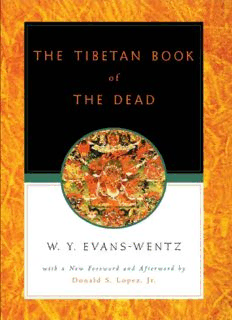
The Tibetan Book of the Dead or the After-Death Experiences on the Bardo Plane PDF
Preview The Tibetan Book of the Dead or the After-Death Experiences on the Bardo Plane
THE TIBETAN BOOK OF THE DEAD (reading left to right) THE TRANSLATOR AND THE EDITOR IN GANGTOK, SIKKIM Described on page xxvii FOLIOS 35A AND 67a OF THE BARDO THODOL MS. Described on page xxvii THE TIBETAN BOOK OF THE DEAD OR The After—Death Experiences on the Bardo Plane, according to LāMa Kazi Dawa—Samdup’s English Rendering Compiled and edited by W. Y. Evans-Wentz with a new Foreword and Afterword by Donald S. Lopez, Jr. Oxford New York Athens Auckland Bangkok Bogotá Buenos Aires Calcutta Cape Town Chennai Dar es Salaam Delhi Florence Hong Kong Istanbul Karachi Kuala Lumpur Madrid Melbourne Mexico City Mumbai Nairobi Paris Sāo Paulo Singapore Taipei Tokyo Toronto Warsaw and associated companies in Berlin Ibadan Copyright © 1960, 2000 by W. Y. Evans—Wentz First published by Oxford University Press, London, 1927 Second Edition, 1949 Third Edition, 1957 First issued as an Oxford University Press paperback, 1960 New Foreword and Afterword copyright © 2000 by Donald S. Lopez, Jr. Published by Oxford University Press, Inc., 198 Madison Avenue, New York, New York 10016 Oxford is a registered trademark of Oxford University Press All rights reserved. No part of this publication may be reproduced, stored in a retrieval system, or transmitted, in any form or by any means, electronic, mechanical, photocopying, recording, or otherwise, without the prior permission of Oxford University Press. Library of Congress Cataloging—in—Publication Data Karma—glin—pa, Library of Congress Cataloging—in—Publication Data Karma—glin—pa, 14th cent. [Bar do thos grol. English] The Tibetan book of the dead; or, The after—death experiences on the Bardo plane, according to LāMa Kazi Dawa—Samdup’s English rendering / compiled and edited by W.Y. Evans—Wentz; with a new foreword and afterword by Donald S. Lopez, Jr. p. cm. Includes Index. ISBN 0—19—513311—0 —ISBN 0—19—513312—9 (pbk.) 1. Intermediate state—Buddhism—Early works to 1800. 2. Death— Religious aspects—Buddhism—Early works to 1800. 3. Funeral rites and ceremonies, Buddhist—China—Tibet—Early works to 1800. I. Title. BQ4490.K3713 2000 294.3’423—dc21 00—022529 13 5 7 9 8 6 4 2 Printed in the United States of America on acid free paper IN MEMORY OF MY DECEASED FATHER AND MOTHER I DEDICATE THIS BOOK TO MY TEACHERS BOTH SECULAR AND RELIGIOUS IN EUROPE AND AMERICA AND THROUGHOUT THE ORIENT ‘Thou shalt understand that it is a science most profitable, and passing all other sciences, for to learn to die. For a man to know that he shall die, that is common to all men ; as much as there is no man that may ever live or he hath hope or trust thereof; but thou shalt find full few that have this cunning to learn to die. . . . I shall give tliec the mystery of this doctrine; the which shall profit thec greatly to the beginning of ghostly health, and to a stable fundament of all virtues.’— Orologium Sapnenliae. ‘Against his will he dieth that hath not learned to die. Learn to die and thou shalt learn to live, for there shall none learn to live that hath not learned to die.’— Toure of all Toures: and Teacheth a Man for to Die. The Book of the Craft of Dying (Compcr’s Edition). ‘Whatever is here, that is there ; what is there, the same is here. He who seeth here as different, mectcth death after death. ‘By mind alone this is to be realized, and [then] there is no difference here. From death to death he goeth, who seeth as if there is difference here.’— Katha Upunish ad, iv. io—n (Swami Sharvananda7 Translation). FOREWORD Donald S. Lopez, Jr. A certain trepidation attends the decision to accept an invitation to write a foreword to new editions, published in 2000, of the four books of W. Y. Evans—Wentz: The Tibetan Book of the Dead, Tibet’s Great Yogi Milarepa, Tibetan Yoga and Secret Doctrines,and The Tibetan Book of the Great Liberation.The four books in their old editions are already burdened with numerous prefaces, commentaries, and introductions, causing one to wonder what another preface could possibly add. It seems inevitable that the four books of Evans—Wentz will continue to outlive yet another generation of commentators, such that anything that a scholar might add today will only serve as material for a scholar some fifty years from now, who will demonstrate the biases and misunderstandings of a preface written fifty years ago, a preface that merely offers evidence of the fin de siécle Zeitgeist of those who once called themselves postmoderns. The four books of Evans—Wentz are surely ground—breaking works, the first to bring translations of Tibetan Buddhist texts to the English—speaking public. Evans—Wentz was equally avant garde in his method, collaborating closely with Tibetan scholars, a practice that would not become common for another four decades, after the Tibetan diaspora began in 1959. Yet, for the scholar of the present day, looking back now more than seventy years to the publication of
Description: